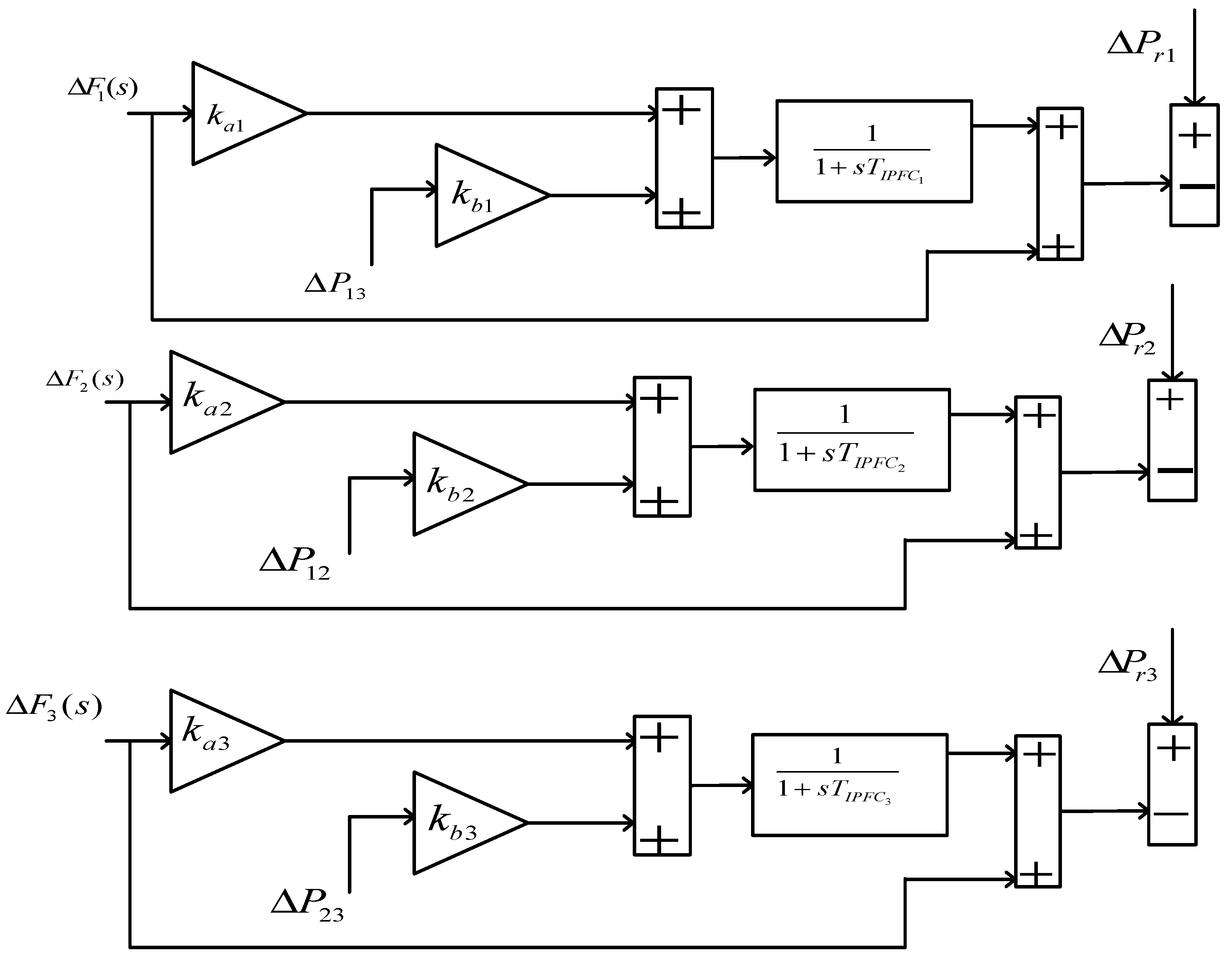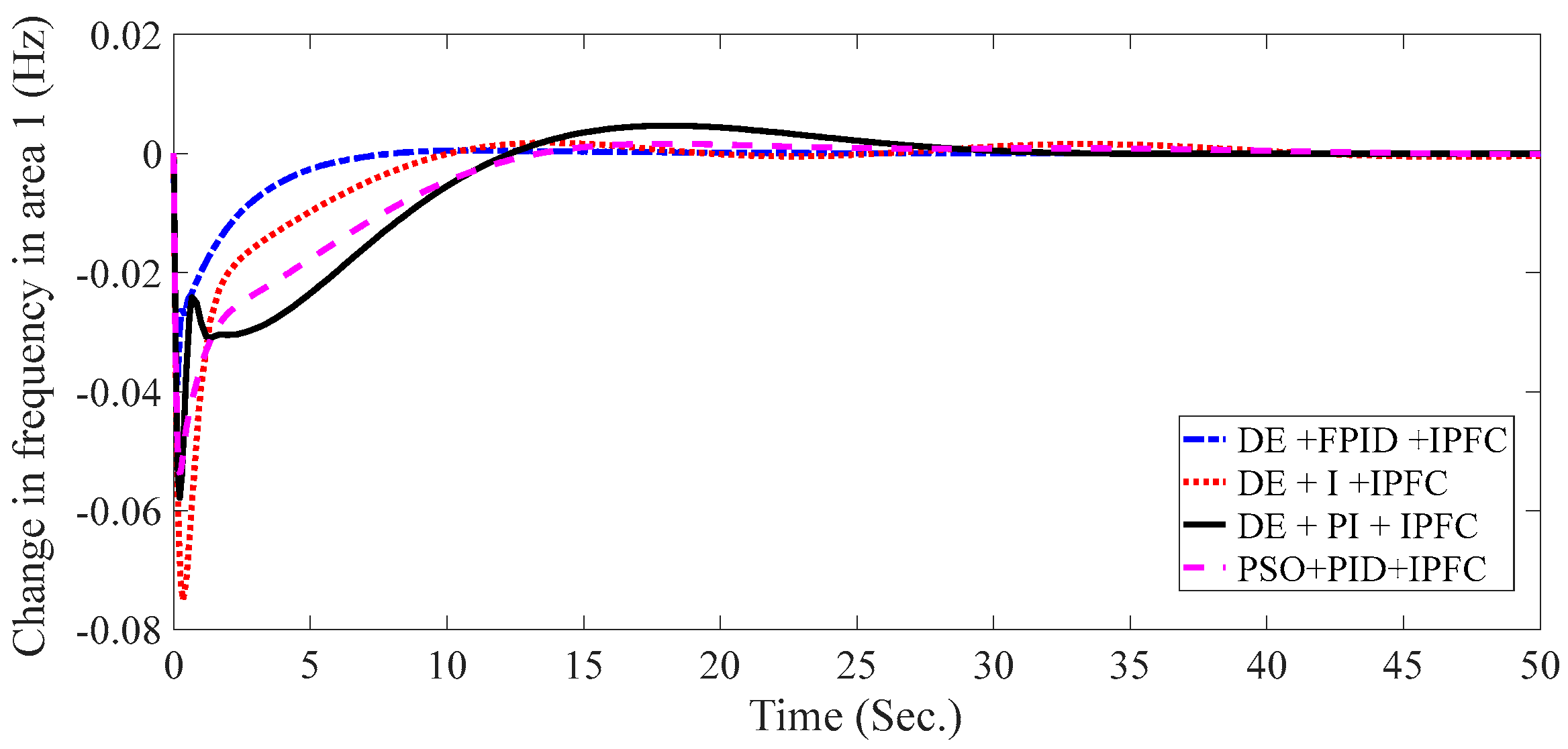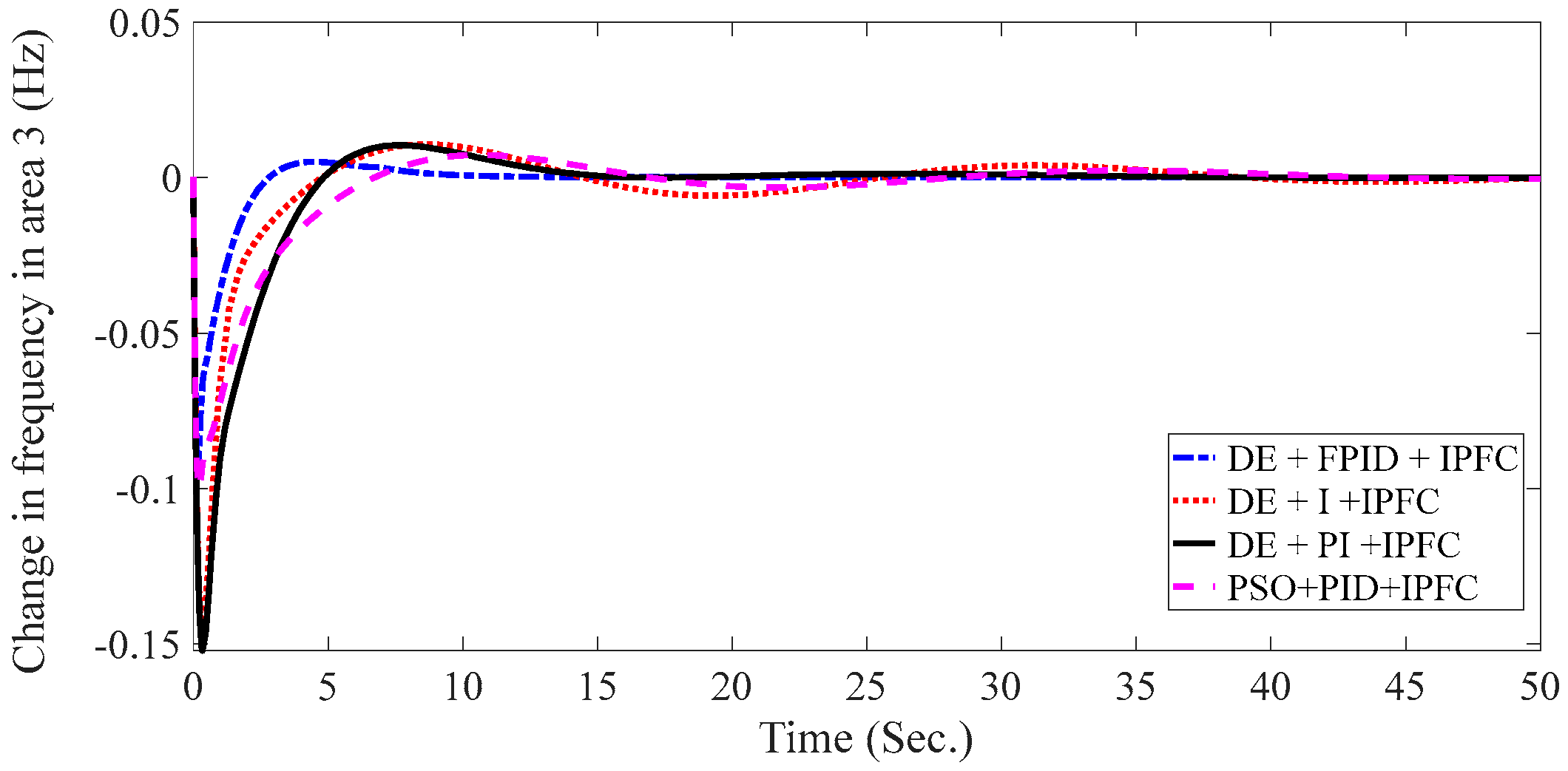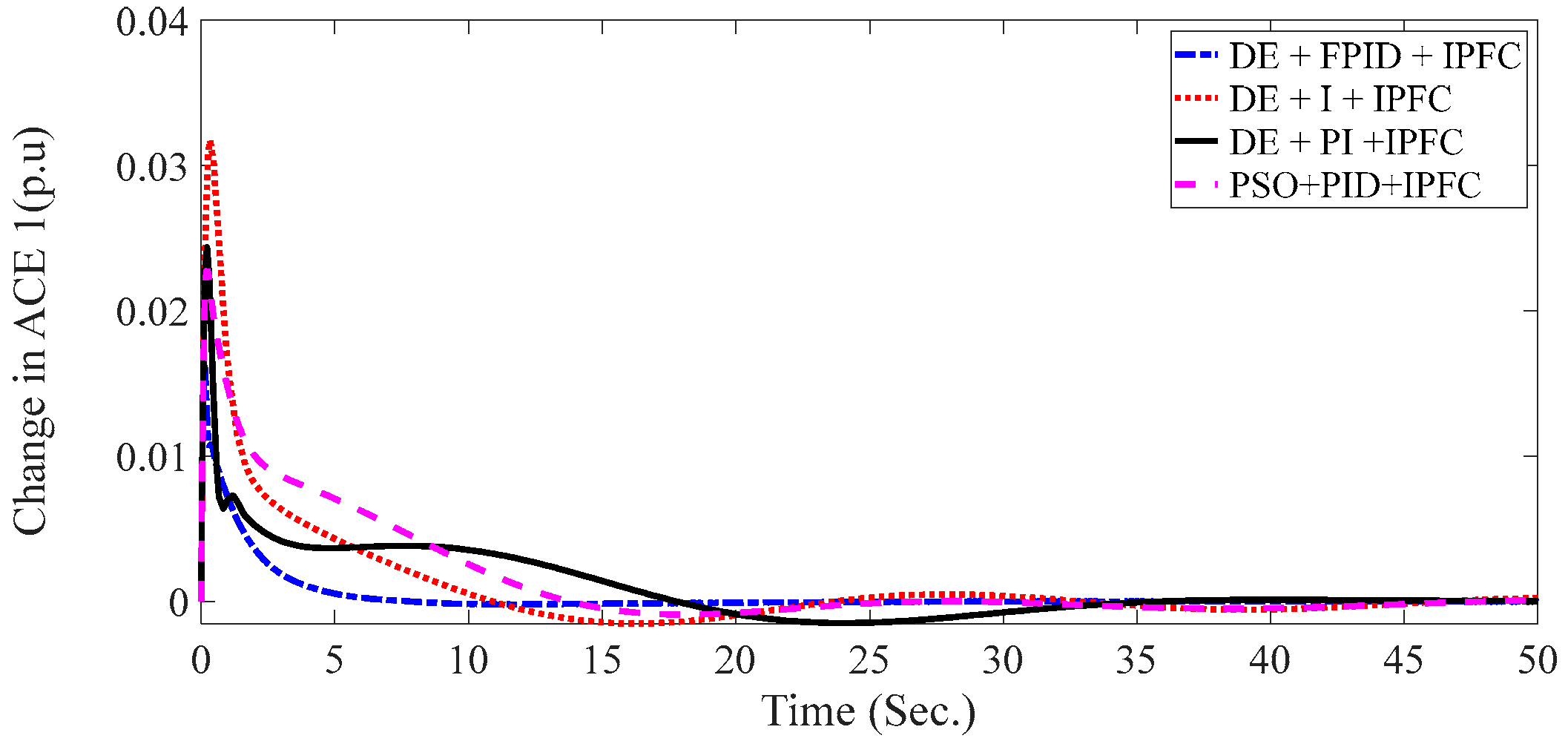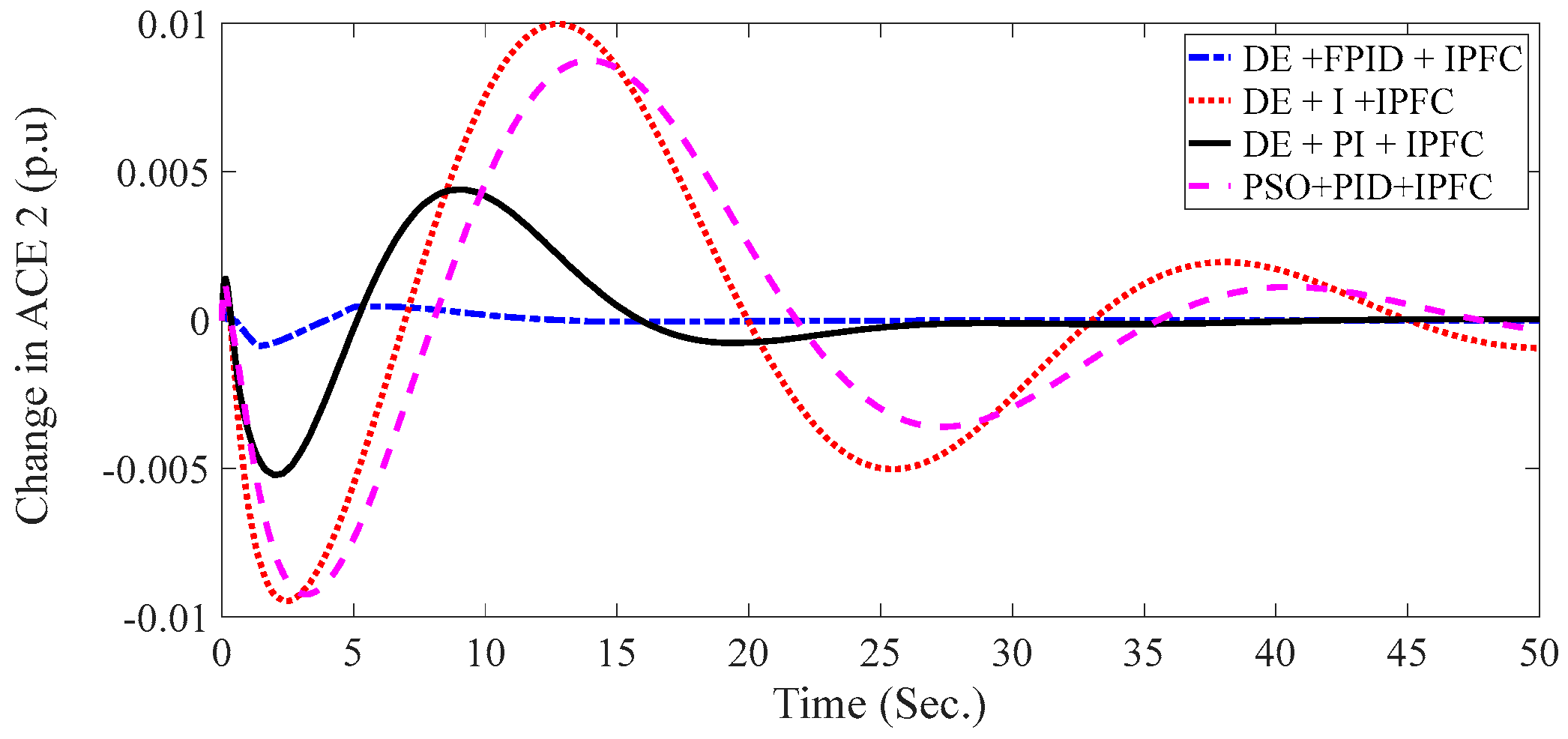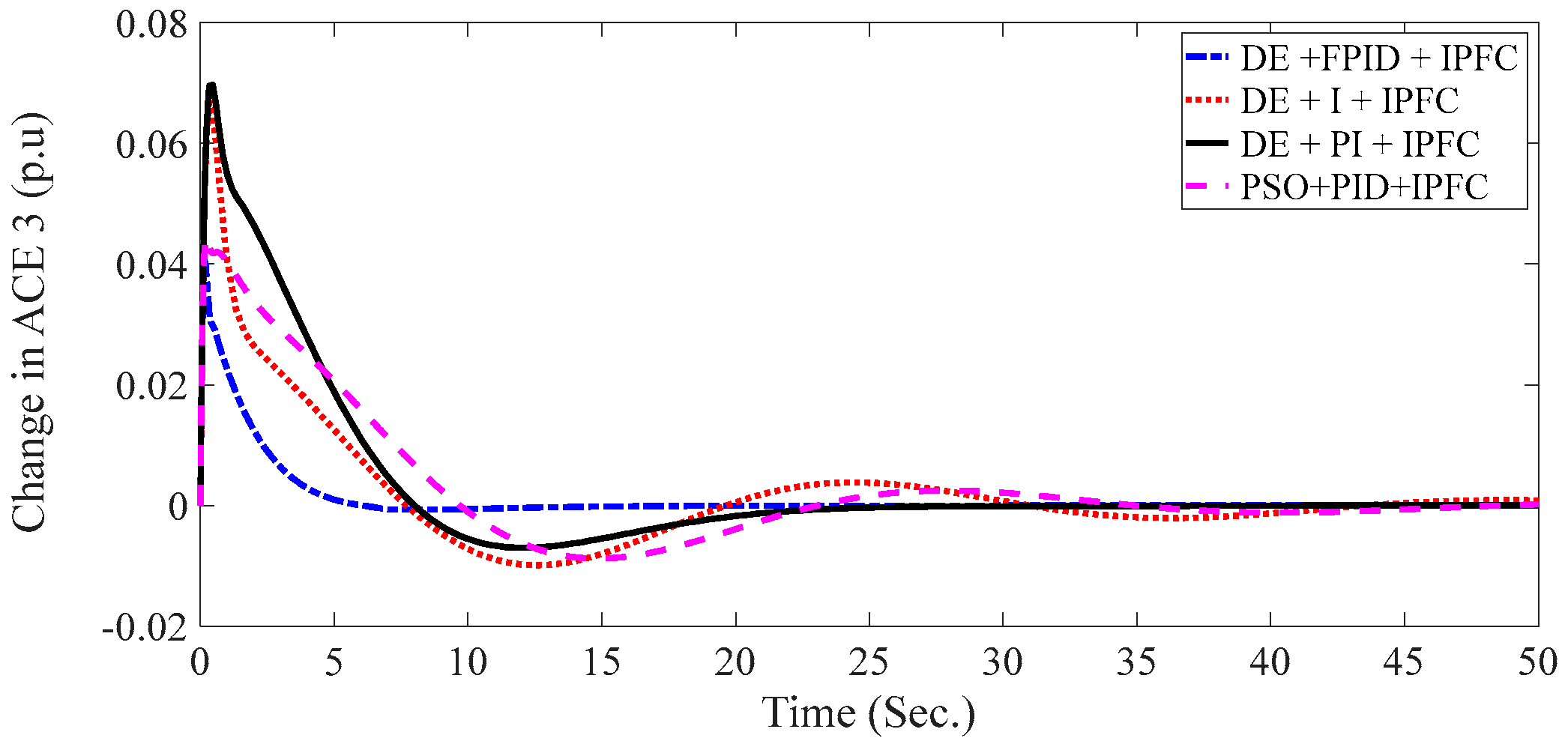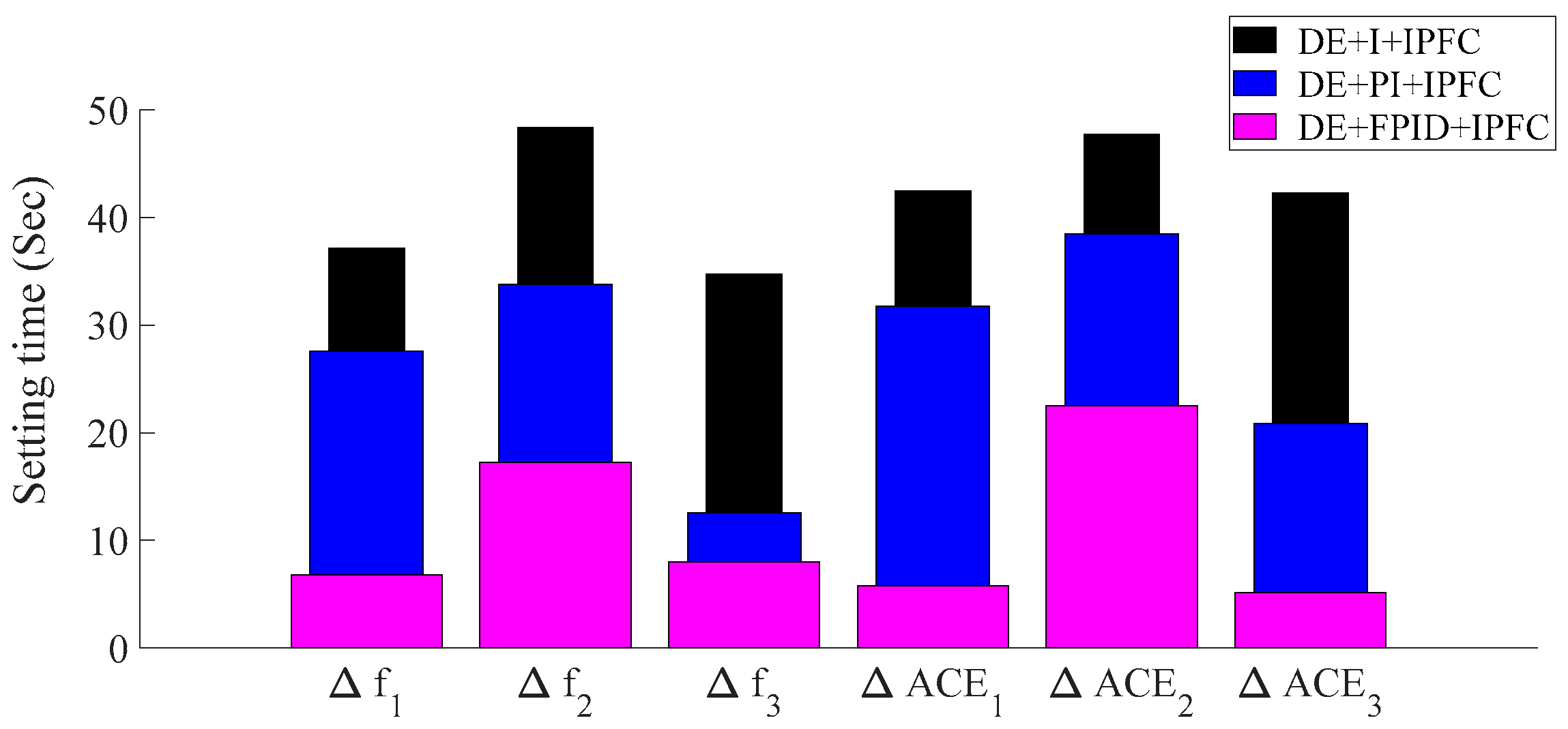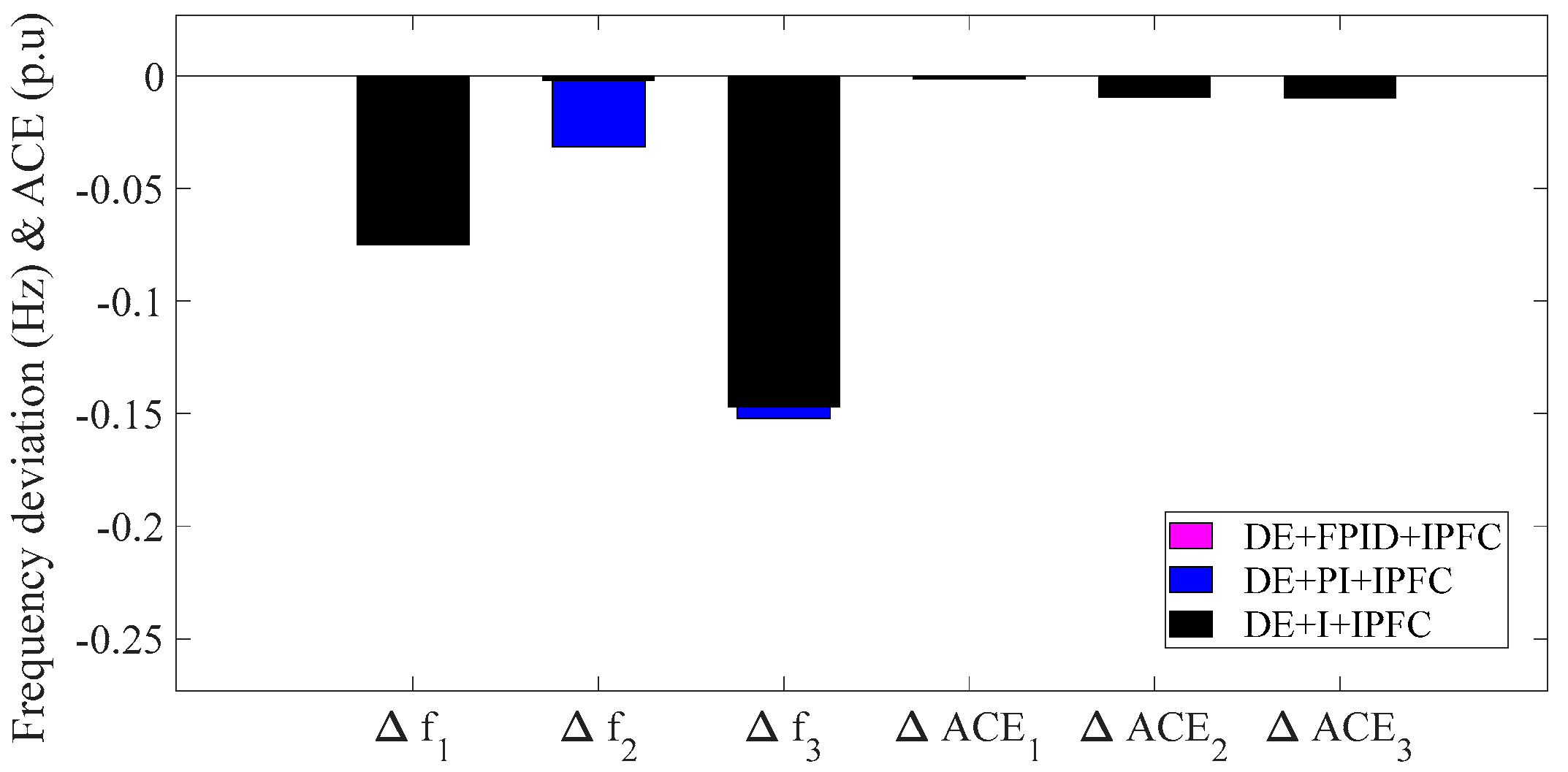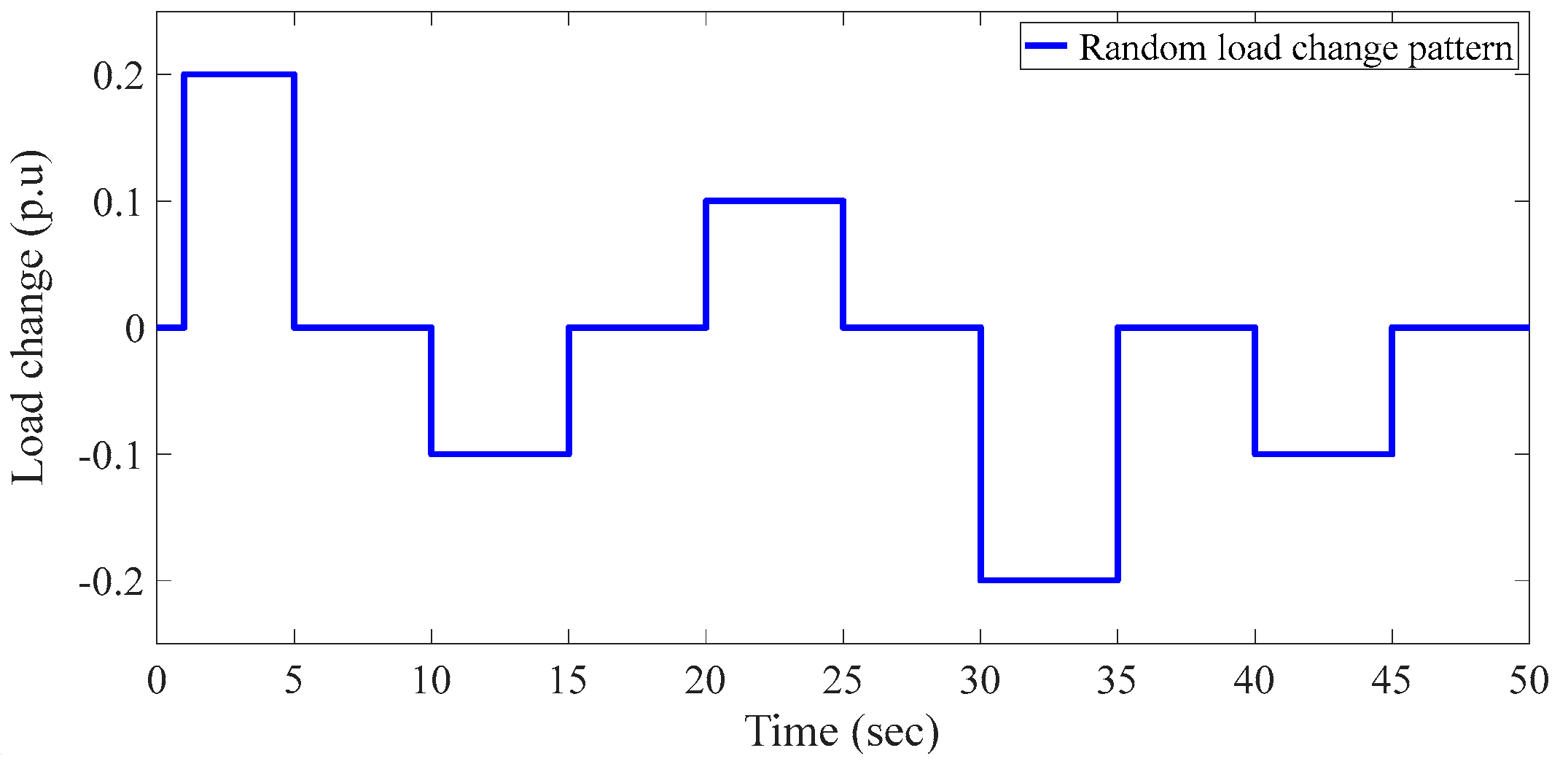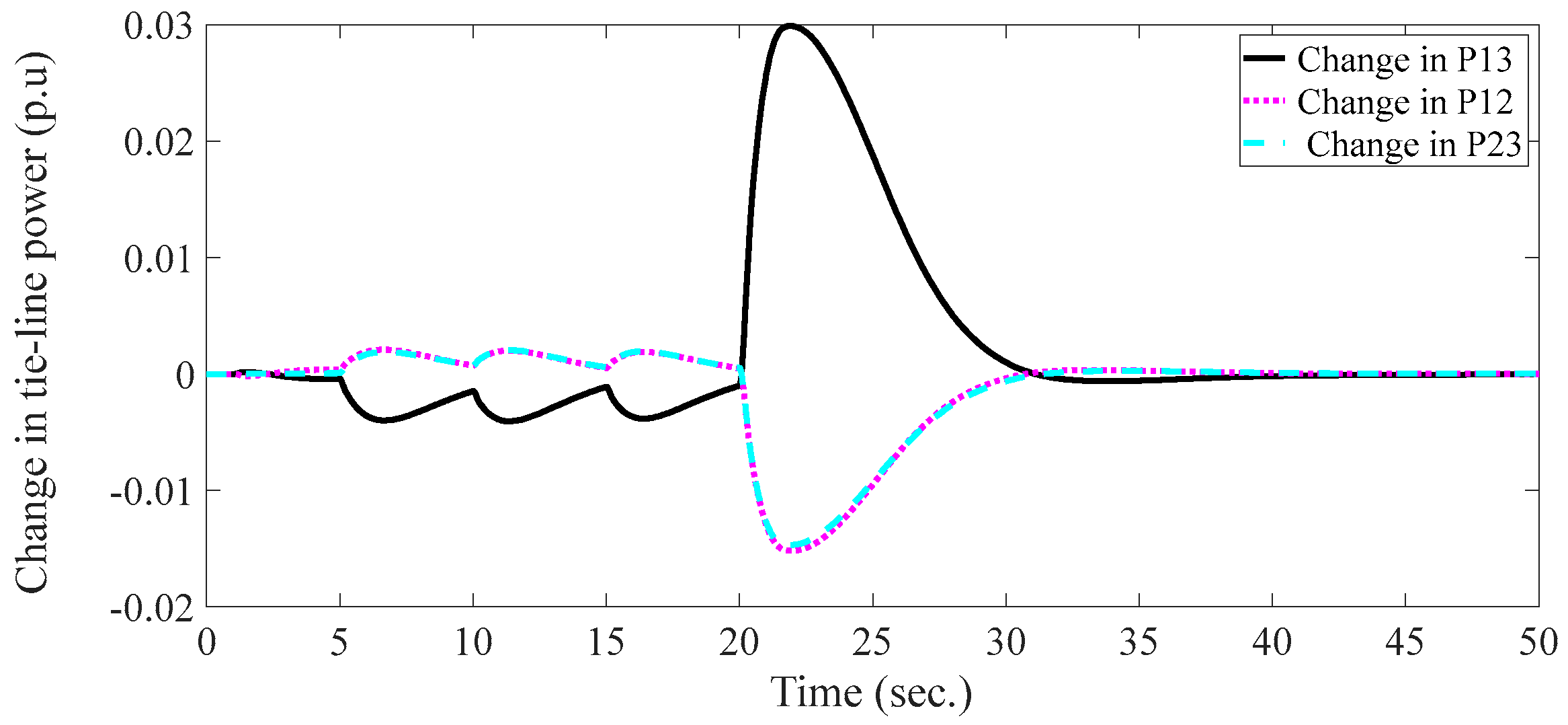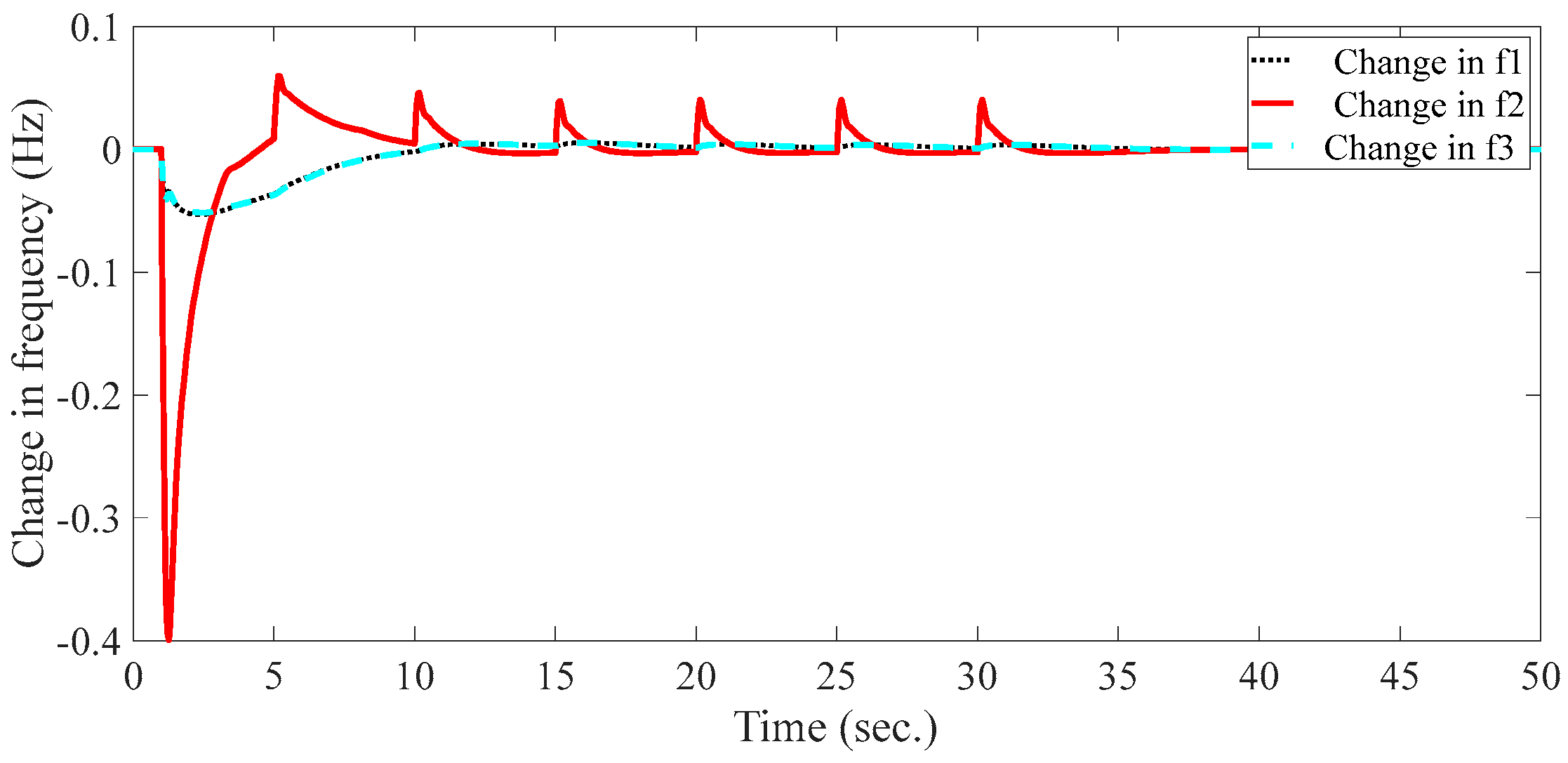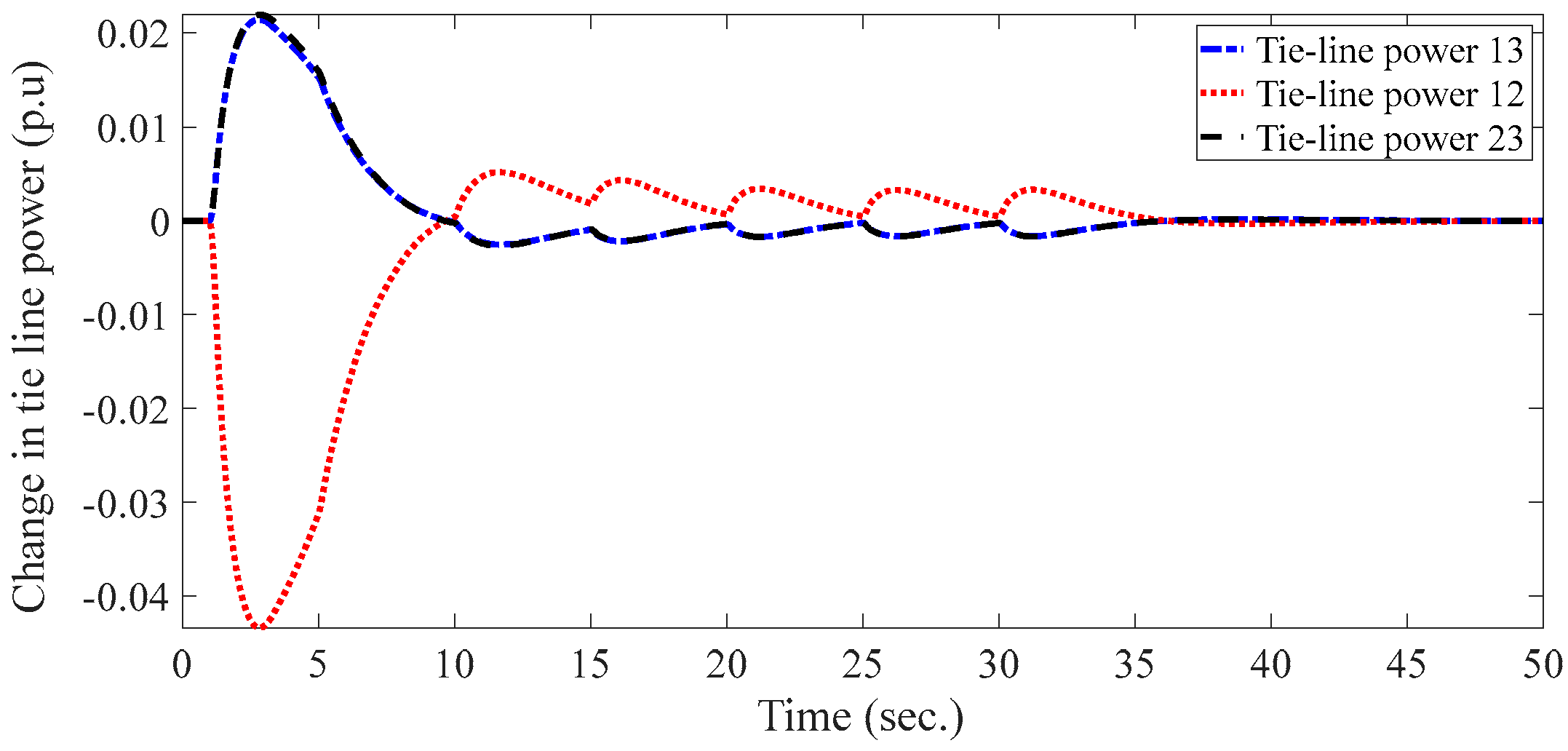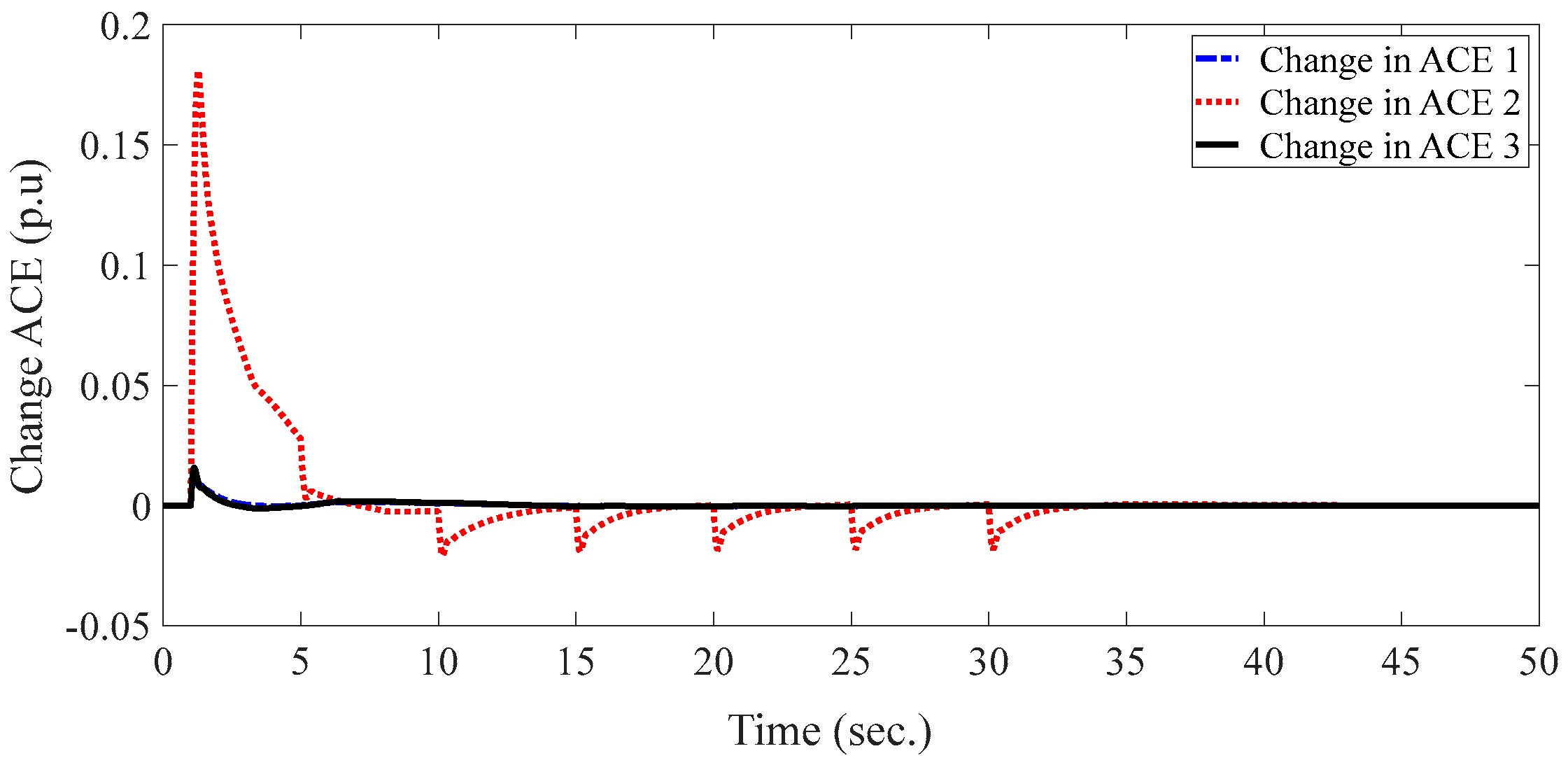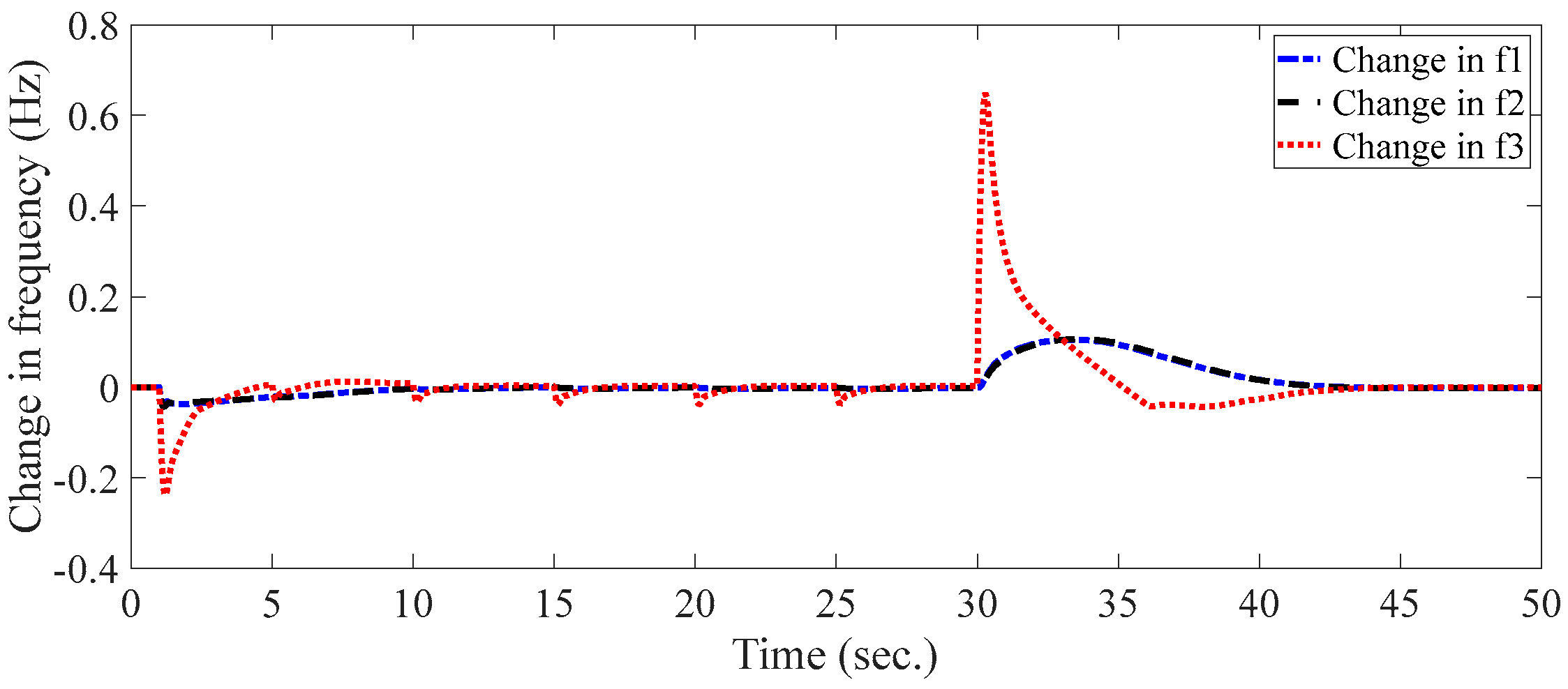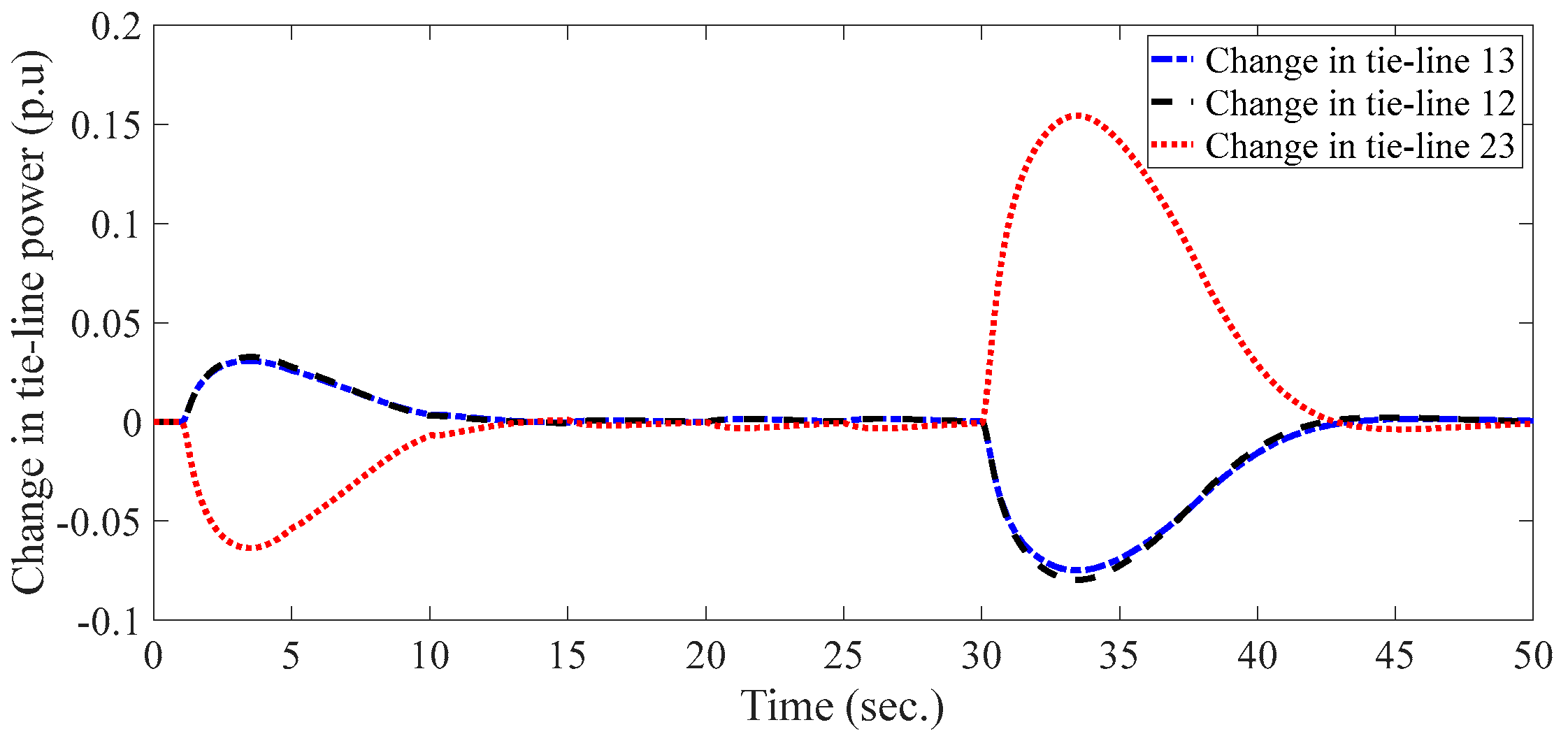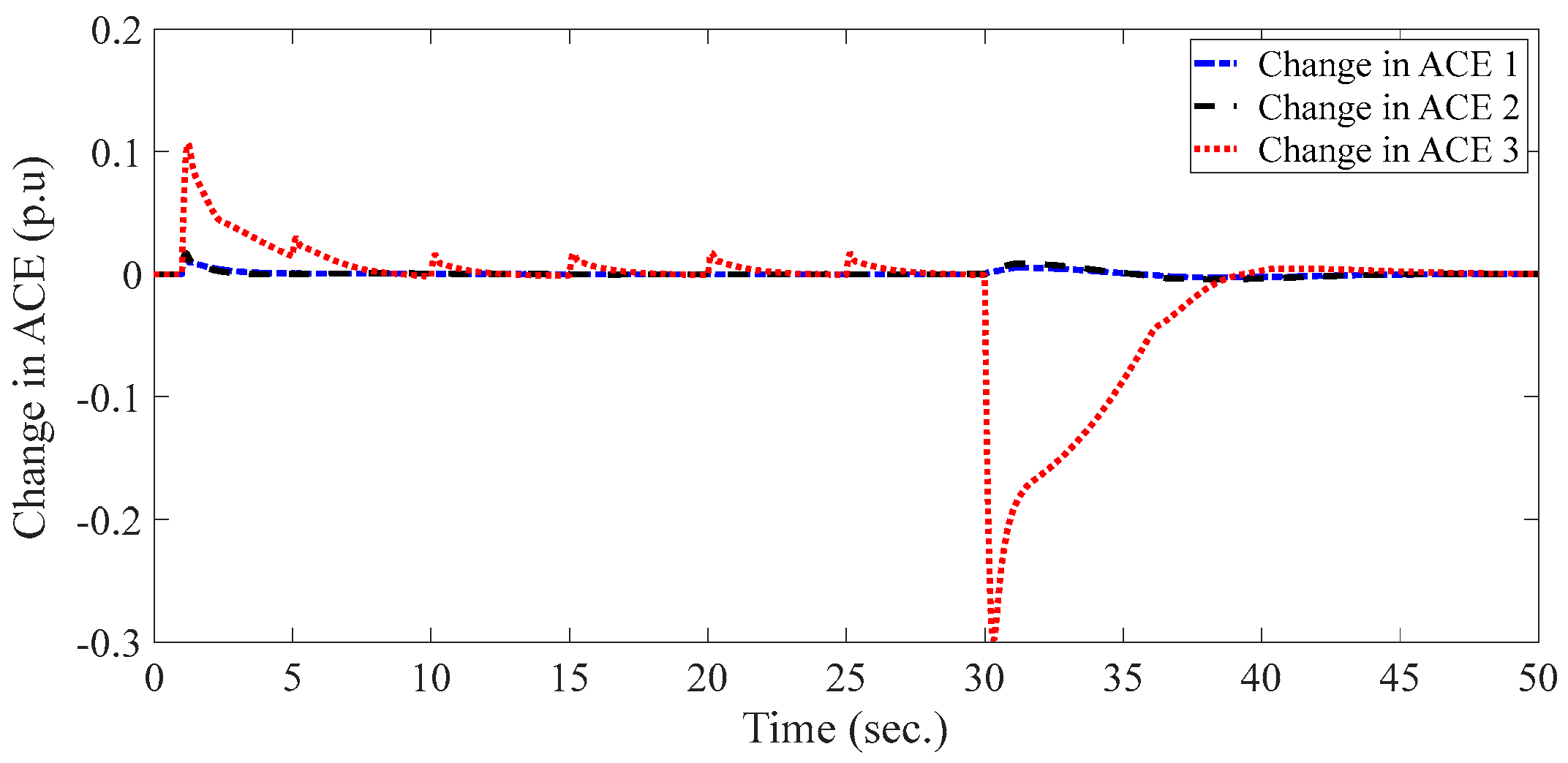1.3. Literature Review
The power system reliability and transfer capability of the complex network can be improved by the combination of FACTS and intelligent controllers, which supports the enhancement of the dynamic stability, reduces the power loss, increases the power transfer efficiency, is involved in voltage regulation, etc. In Ref. [
1], intelligent controllers such as the fuzzy controllers in combination with GA were designed in a single area to determine the AGC of the power system, and hence GAFLC was chosen as a controller that withstands hardships and clears any fault during load perturbation; thus, the authors of this paper proved that the fuzzy controller was a good controller. In Ref. [
2], the authors provided a thorough review of AGC, including its numerous models, operations, applications of energy storage and FACTS devices, participation with renewable energy, use of AGC techniques in smart grids and microgrids, and its control function in economic dispatch. In Ref. [
3], a FPID controller was optimized by using a whale optimization technique to control a power system with three areas of AGC to regulate the tie-line power and frequency deviations. This study also aimed to minimize the ACE, and by minimizing the power production costs to minimize the marginal cost, compared to the GA and PSO, the proposed controller performed better.
The ability of the intelligent controller FPID to exert AGC of a three-area power system was optimized by using the DE technique, and the power system performed better even in a variety of random load scenarios [
4]. In Ref. [
5], a comparison between the conventional speed governor control loop with fuzzy control and fuzzy control with AVR was performed. In Ref. [
6], a better dynamic power system operation was obtained by using GA optimization techniques for the AGC of interconnected systems. The tuning of the PID controller with single optimization and hybrid optimization using DE and GA to control the power systems with AGC was studied by using single- and multiobjective optimization, and the authors achieved better results with the hybrid system [
7]. The authors of [
8] combined intelligent controllers such as fuzzy and ANN controllers to create a hybrid of HFNN to control isolated and multiarea power systems, and they achieved better results with lower errors, faster operations, and lower transients. The authors of Ref. [
9] studied various methods used to control the power systems such as combining an integral controller with a FACTS device and employing TLBO methods to tune the FPID by considering nonlinearity and some physical constraints in the tuning process by using various objective function criteria for the minimization such as IAE, ITSE, ITAE, and ISE. The study also considered a comparison of the UPFC, TCSC, TCPS, and SSSC of various FACTS devices, and the results revealed that with the placement of the UPFC, the minimum objective value was attained.
In Ref. [
10], a comprehensive review of the LFC control strategy, considering both opportunities and challenges, was conducted by taking into account the conventional, future, and smart grid power systems from single area to multiarea systems. In Ref. [
11], conventional PI and fuzzy PI controllers were employed in multisource power systems of hydro and thermal energy, and the authors achieved better-improved results with the fuzzy PI controller. In Ref. [
12], the authors revealed that even though various loading conditions were applied to the system, the fuzzy PID controller optimized by DEPSO achieved better results.
In Ref. [
13], a multisource power was optimized by using the hybrid GWO-TLBO technique; the authors used a cascaded PD-fuzzy-PID controller by considering the disturbance in area 1 and by analyzing the AC-DC tie line. UPFC was also employed to improve the frequency stability. In Ref. [
14], a grasshopper optimization algorithm was introduced to optimize the ability of the proposed PDF plus (1 + PI) controller to exert AGC on a power system to obtain more feasibility validations of the proposed controller. A sensitivity analysis test with numerous load patterns and a real-time simulation was carried out. In Ref. [
15], a hybrid DE-GWO technique was proposed for multisource power systems including gas, hydro, and thermal turbines.
In Ref. [
16], a fuzzy logic-based controller was proposed in an LFC system that incorporated a wind farm with 10 generators with 39 bus systems in all areas. To increase the optimal performance, the membership function parameters were optimized via PSO, and the result were compared with the conventional LFC design. In Ref. [
17], gain parameters such as the frequency bias and speed regulation were optimized by using the bacteria foraging optimization method to exert AGC on the three unequal-area thermal power systems; the results revealed that the BF optimization method was faster than GA and the classical or conventional ones.
In Ref. [
18], the authors discuss various AGC aspects such as classical optimal, centralized, decentralized, linear, nonlinear, adaptive, self-tuning, intelligent/soft computing, digital, and multilevel control, as well as AGC incorporating FACTS devices such as PV systems.
In Ref. [
19], a two-area multisource power system was optimized by using GWO in the FPID controller, and the performance of the controller was assessed by adjusting the different random load disturbances. In Ref. [
20], IACO was used to optimize the FPID controller in the LFC of a multiarea system. To improve the optimization, some updating algorithm rules and a modified objective function with the appropriate weight coefficient were incorporated as a test system, which enabled it to handle nonlinearity and uncertainty. The dynamic performance was compared with BFOA, PSO, DE, PS, HPSO-PS, and HBFOA-PSO. Additionally, the IACO with FPID was applied.
In Ref. [
21], a performance comparison of classical controllers was studied, but unlike the inelegant controllers, the results were not attractive. In this paper, AGC with a fuzzy logic controller and IPFC FACTS device was proposed for three equal-area thermal power systems. In Ref. [
22], an optimization algorithm based on flower pollution was presented for static VAR compensator tuning. An artificial cuckoo search strategy for LFC’s best PI controller tuning was introduced in Ref. [
23]. A unique optimum PID/FOPID controller for LFC was developed in [
24,
25]. In Ref. [
26], a comparison of GA and modified DE with the FACTS device was performed, and better results were obtained in the presence of DE. In Ref. [
27], the PSO, BFOA, GA, and DE techniques were applied to exert AGC on two-area power systems, and the superiority of the DE optimization technique over the others was discussed. In Ref. [
28], the results from the craziness-based PSO were compared with DE methods to determine the AGC of interconnected power systems with nonlinearity, and the result from the DE technique analysis were better. In Ref. [
29], the proposed hADE-PS-based FOFPID controller was compared with the Firefly Algorithm (FA) and TLBO techniques when tuning the FPID to determine the frequency control of the power systems. The majority of the metaheuristic techniques are inspired by nature. Among these are well-known methods such as PSO, GA, and Ant Colony Optimization (ACO). A common feature of these algorithms is that they do not depend on the surface gradient, which frees them from the limitations associated with the gradient-based algorithm, which is the ‘local minima trap’. The ‘Global best’ solution is the best solution that can possibly be discovered [
30]. A metaheuristic-based fuzzy PID controller with a minimizing objective function was proposed by the authors of [
31] for AGC in the presence of FACTS. Hybrid metaheuristic optimization techniques were applied by the authors of [
32] to solve LFC problems. Moreover, such algorithm-based controllers provided robust and reliable frequency control. The ability of a Firefly Algorithm optimized two-degree-of-freedom PID (2DOF PID) controller to exert AGC of a multiarea interconnected system with FACTS was studied in [
33]. The characteristics and operators of RDA were addressed by the authors of [
34], who employed several adaptive algorithms for better RDA efficiency (IRDA). The improved grey wolf optimization method and the cuckoo search algorithm, known as the MGWO-CS algorithm, were taken into consideration by the authors of [
35]. While designing a TID controller to exert frequency control on a two-area power system by using a photovoltaic system, the authors compared the controller to the original hybrid algorithm in terms of the implementation time and solution quality. The writers of [
36] conducted research on electric cars, the specifications for the properties of their batteries, a proposed integrated vehicle identification number (VIN) code, and the coordination code used. The creators of [
37] studied the behavior of Scottish red deer to create a novel metaheuristic algorithm that was inspired by nature. They also took into account many functions and several objectives while solving engineering challenges with the best possible solutions. The authors of [
38] applied the optimization to a simple, intelligent, and new single-solution algorithm with different steps. The social engineering optimizer (SEO) starts with the attacker and defender principle. In order to resolve a number of benchmark functions and significant engineering and multiobjective optimization issues, the SEO is used. The authors of [
39] compared the proposed controller to the PID controller and employed the hybrid PID-fuzzy controller to achieve optimum AGC of a two-area linked power system. The optimum transient response output of the parameters in both controllers was achieved by using the simulated annealing approach. The simulation results based on simulated annealing (SA) in consideration of the hybrid PID-fuzzy controller were the best. The authors of [
40] investigated ways to create a unique control strategy by focusing on the model predictive controller as well as Leader Harris Hawks optimization to determine how to control the voltage and frequency of renewable power systems. The whale optimization algorithm (WOA) was used by the authors of [
41] to solve the AGC issue. The authors of [
42,
43,
44] discussed the advancements made from the first recorded usage of control systems, spanning from the fractional PID to the most recent developments in this area.
This paper presents the optimization of intelligent and conventional controllers with IPFC FACTS devices to enhance AGC. The remaining paper is structured as follows: In
Section 2, the system modeling, methods, and tools are described.
Section 3 provides the results. Discussions are given in
Section 4. Lastly, the conclusions and future scope are presented in
Section 5.


